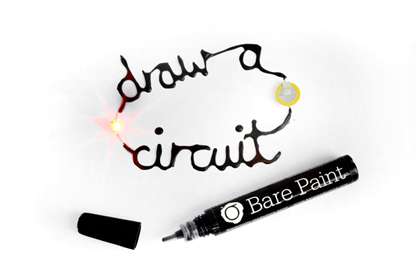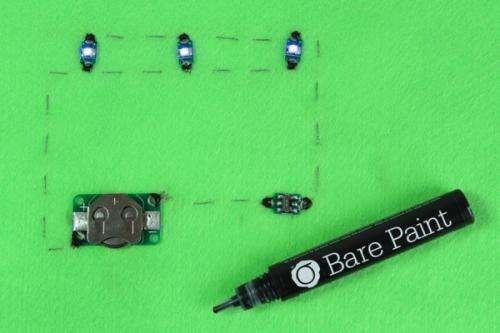May 26, 2013 weblog
Conductive paint lands in pens and pots for creatives

London-based Bare Conductive Ltd. makes electrically conductive paint called Bare Paint. The substance allows the painting of "liquid wiring" on any surface. Except for skin, you can apply its paint on walls and assorted surfaces to conduct electricity. "Bare Paint" began as a project by the inventors, then students, at the Royal College of Art. Despite all the jokes about Wikipedia as a questionable knowledge crutch, the inventors credit Wikipedia as having helped them to learn what they had to know about working with conductive materials to get something going. In 2011 the RCA graduates were able to introduce Bare Paint.
Nontoxic and drying at room temperature, the product has caught on with educators, DIY makers and inventors. They have a number of products on sale, and Radio Shack stocks their paint pen.. Paper as a vehicle for delivering more information than immediately meets the eye via the painted object—that is what they see as their opportunity. Applications for their paint can easily translate into talking billboards and walls, where objects on surfaces turn interactive. A light switch painted on paper, when touched, can turn on a light, or a touch on a poster object can make a sound.
Wanting to expand in recognition, they hope to appeal to a wide creative gamut of hobbyists, artists, and engineers for innovative ways to use their products. Bare Paint, they emphasized, is the first non-toxic electrically conductive paint available. As such the substance is child friendly, which opens the door to educational projects, including toys, and touch-sensitive paper drawings that play sounds.
"We generally split applications into two simple classifications, signaling and powering," they said. "Signaling could include using the Paint as a potentiometer while interfacing with a micro-controller, as a conduit in a larger circuit or as a capacitive sensor. Powering a device would include lighting LED's or driving small speakers. The most interesting stuff happens when you combine these properties into something new."
According to the company, Bare Paint has a surface resistivity of approximately 55 ohms/square at 50 microns layer thickness.

The product is water-based but it is not waterproof. One can paint over it with a waterproof paint or varnish, they said, depending on the application. The paint is only available in black, but it can be over-painted with any material with a wide range of other paints.
More information: www.bareconductive.com/
© 2013 Phys.org


















